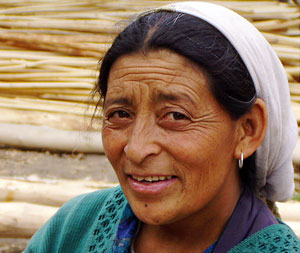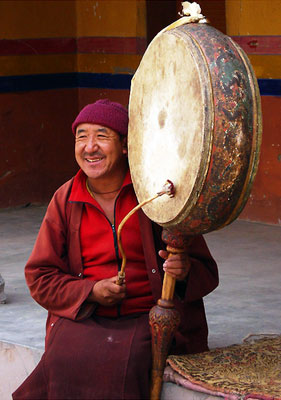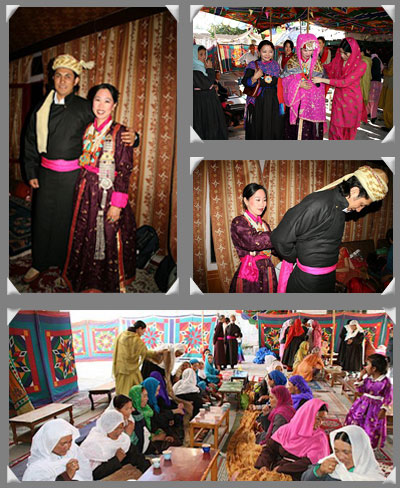|
|
|
Ladakh People |
|
|
|
People of Ladakh
The faces and physique of the Ladakhis, and the clothes
they wear, are more akin to those of Tibet and Central
Asia than of India. The people of Ladakh are
predominantly Buddhist and practice Mahayana Buddhism
influenced with the old Bon animistic faith and Tantric
Hinduism. Bon religion and Tantrism involved rituals to
fulfill the wishes and so they were very popular before
Mahayana Buddhism dominated. The people of Ladakh are
very hardy and tough like the rugged mountains and also
very soft and plain. With round faces, short noses, and
chinki eyes they |
 |
|
|
resemble more to the people
of Tibet and central Asia. The original population is believed
to have been that of Dards, an Indo-Aryan race from down the
Indus. But over years, a huge influx from Tibet overwhelmed
the culture of the Dards and obliterated their racial
characteristics. In eastern and central Ladakh, there are
Tibetans. Further west, in and around Kargil, there is much in
the people's appearance that suggests a mixed origin. The
exception to this generalization is the "Arghon", a community
of Muslims in Leh, the descendants of marriages between local
women and Kashmiri or Central Asian merchants. There are four
main groups of people. The Mons who are of Aryan stock are
usually professional entertainers, often musicians. The Dards
are found along the Indus valley, many converted to Islam,
though some remained Buddhist. Tibetans form the bulk of the
population in Central and Eastern Ladakh, though they have
assumed the Ladakhi identity over generations. The Baltis who
are thought to have originated in Central Asia, mostly live in
the Kargil region. The Ladakhis are cheerful and live close to
nature. The Ladakhis wore the goncha which is a loose woollen
robe tied at the waist with a wide coloured band. Buddhists
usually wear dark red while Muslims and nomadic tribes often
use undyed material. |
|
|
|
Influence of
Buddhism in Ladakh
Twelve centuries after the Buddha attained 'nirvana',
the Tibetan King Songstsen Gampo (Sron-bTsan Sgam-Po)
who ruled from 618 to 649 AD, married Wen Chen from the
court of China's Tang dynasty and Bkrikuti Devi, a
Nepalese princess. Under their influence, Buddhism
slowly developed in the Central Himalayan and Trans
Himalayan regions of Tibet, Spiti, Lahaul and Ladakh
till it became the predominant faith. Buddhism is the
way of life in Ladakh. Buddhism reached Tibet from India
via Ladakh, and there are ancient Buddhist rock
engravings all over the region, even in areas like Drass
and the lower Suru valley which today are inhabited by
an exclusively Muslim population. The division between
the Muslims and Buddhists in Ladakh passes through
Mulbekh (on the Kargil-Leh road) and between the
villages of Parkachick and Rangdum in the Suru Valley,
though there are pockets of Muslim population further
east, in Padum (Zanskar), Nubra Valley and in and
|
 |
|
|
around Leh. The approach to
a Buddhist Village is invariably marked by 'Mani' walls, which
are long chest-high structures faced with engraved stones
bearing the Mantra "Om Mane Padme Hum" and by 'Chorten',
commemorative cairns, like stone pepper-posts. Many villages
are crowned with a Gompa or monastery, which may be anything
from an imposing complex of temples, prayer halls and monks
dwellings, to a tiny hermitage housing a single image and home
of a solitary Lama.
The Muslim Inhabitants
Islam too came from the west. There is a peaceful penetration
of the 'Shia' sect spearheaded by missionaries. Its success
was guaranteed by the early conversion of the sub-rulers of
Drass, Kargil and the Suru Valley. In these areas, 'Mani'
walls and Chorten are replaced by mosques, small unpretentious
buildings, or 'Imambaras', the imposing structures in the
Islamic style, surmounted by domes of sheet metal that gleam
cheerfully in the sun.
Women of Ladakh
In Leh, women of both the communities, Buddhist and Muslim,
enjoy a greater freedom than other parts of the region. They
not only work in the house and field, but also do business and
interact freely with men other than their own relations. In
Kargil and its adjoining regions, it is only in the last few
years that women are merging from semi-seclusion and taking
jobs other than traditional ones like farming and
house-keeping.
Traditional Rituals & Leisure Activities in Ladakh
The monastic and other religious festivals, many of which fall
in winter, provide the excuse for convivial gatherings. The
Ladakhi Buddhists are very happy people who love dancing, music
and sports. Their favourite sports are archery and polo. In
Leh, and may of the villages, archery festivals are held
during the summer months, with a lot of fun and fanfare.
Different teams from surrounding villages compete with each
other in these archery festivals, and the shooting takes place
according to strict etiquette, to the accompaniment of the
music of surna and daman (oboe and drum). Most Ladakhis are
farmers and they make their living by ploughing their small,
dry plots with sturdy Dzos, cattle crossbred from yaks and
hill cows. People living in villages survive on a simple diet
of roasted barley or buck-wheat flour called Tsampa. They
drink green salt tea mixed with yak butter. Among the
Buddhists, these often develop into open-air parties
accompanied by dance and song, at which Chang, the local beer
made from fermented barley, flows freely.
Oral Tradition in Ladakh
Of the secular culture, the most important element is the rich
oral literature of songs and poems for every occasions, as
well as local versions of the "Kesar Saga", the Tibetan
national epic. This literature is common to both Buddhists and
Muslims. In fact, the most highly developed versions of the
Kesar Saga, and some of the most exuberant and lyrical songs
are said to be found in Shakar-Chigtan, an area of the western
Kargil district exclusively inhabited by Muslims,
unfortunately not freely open to tourists yet.
Ceremonies in Ladakh
Ceremonial and public events are accompanied by the
characteristic music of 'Surna' and 'Daman' (Oboe and drum),
originally introduced into Ladakh from Muslim Baltistan, but
now played only by Buddhist musicians known as "Mons". The
first year of childbirth is marked by celebrations at
different intervals of time, Beginning with a function held
after 15 days, then after one month, and then again at the end
of year. All relatives, neighbors and friends are invited and
served with 'Tsampa', butter and sugar, along with tea by the
family in which the child is born. |
|
|
|
Wedding in Ladakh
There is a mix of music and dance, joy and laughter, in
the air whenever a marriage is held. The first day is
spent in feasting at the bride's house, the second at
the groom's place. The bride goes to live in the house
of bridegroom after marriage. Boys are usually married
or promised for marriage at about 16, girls at about 12.
To make a proposal a relative of the boy goes to the
house of the girl and gives a ring together with
presents of butter, tea and 'Chang'. If the gifts are
accepted then the marriage follows some months later.
The boy offers a necklace and clothes to the girl. The
parents of the girl give the couple clothes, animals
|
 |
|
|
and land if they are rich. These gifts are
known as a "Raqtqaq" or dowry. |
|
|
|
Rules of Inheritance
When the father of the family dies his place is taken by the
eldest brother. The other brothers must obey the eldest
brother. All inheritance of the family goes to the eldest
brother and then to the next brother when he dies. If the
family consists of all girls, then the father will bring the
husband of the eldest daughter into the house and all land
stays in the daughter's name and passes to her first son. Both
sets of parents must accept the proposal of the boy for the
girl. Usually the marriage is set by both sets of parents, who
will choose a suitable partner for their child on the basis of
manner, health and ability to earn income and look after a
house.
Astrologers and Oracles of Ladakh
The lamas are the vital intermediaries between the human and
the spirit world. Not only do they perform the rites necessary
to propitiate the gods, they also often take on the role of
astrologers and oracles who predict the auspicious time for
starting any enterprise, or starting ploughing the field,
arranging a marriage or going on a journey. The most famous
monk-oracles are those of Matho Gompa. Chosen every three
years by a traditional procedure, two monks spend several
months in a rigorous regimen of prayer and fasting to prepare
and purify themselves for their arduous role. When the time
comes they are possessed by the deity, whose spirit enables
them to perform feats that would be impossible to anyone in a
normal state such as cutting themselves with knives, or
sprinting along the gompa's topmost parapet. In this
condition, they will answer questions put to them concerning
individual and public welfare. However, the spirit is said to
be able to detect questions asked by sceptical observers with
the intention of testing him, and to react with frenzied
anger. |
|